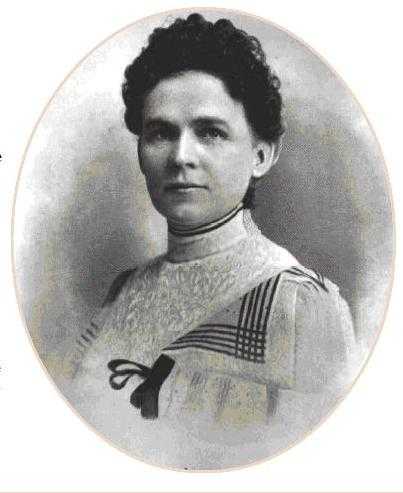Ella Knowles Haskell (July 31, 1860 – January 27, 1911) was an American lawyer, suffragist, and politician. Born in New Hampshire, she moved to Montana to enhance her well being following a bout of tuberculosis and there turned the primary lady to be licensed as a lawyer, the primary feminine notary public, the primary lady to run for Montana State Legal professional Basic, and the 26th lady to be admitted to follow earlier than the US Supreme Court docket. She served because the President of the Montana Equal Suffrage Affiliation and was broadly recognized in Montana for her development of the suffrage motion, political feminism and social fairness.
Early years
Ella L. Knowles was born on July 31, 1860 in Northwood, New Hampshire. She graduated from Northwood Academy on the age of 15 after which attended Plymouth Regular College for one yr. She then taught in nation colleges for a number of years to earn tuition for school.
She attended Bates School, in Lewiston, Maine the place she was the primary feminine editor of the faculty’s scholar journal, the Bates Pupil and was energetic within the Debate Society. Bates was one of many few co-educational faculties within the Northeast at the moment, and she or he graduated with honors in 1884.
In her school-days she was famous for her elocutionary powers, and she or he usually gave dramatic entertainments and acted in newbie theatrical organizations. She obtained her diploma of A. M. in June, 1888, from Bates School, and after hesitating between school-teaching and legislation as a career, she determined to review legislation. Upon graduating from the faculty, she moved to Manchester, New Hampshire, the place she studied legislation with Henry E. Burnham, who was to later grow to be a U.S. senator.
In 1887, she fell in poor health with tuberculosis and was suggested to maneuver to the drier local weather of the Montana Territory to enhance her well being.
She went to Iowa, the place she taught lessons in French and German in a seminary for a short while, and rhetoric and elocution at Western Regular School. She subsequent went to Salt Lake Metropolis, Utah, the place she took a place as instructor. Whereas there, she obtained a proposal of a bigger wage to return to the Iowa College, during which she had taught. She had seen sufficient of the Rocky Mountains and of the individuals of that area to make her prepared to stay within the West.
In 1888, she moved to Helena, Montana and was supplied the job of principal on the West Aspect College. Not lengthy after reaching Helena, she determined to complete her legislation course, and she or he entered a legislation workplace, studying legislation within the Helena workplace of Joseph Kinsley.
In that very same yr, she was appointed a notary public by Governor Leslie, and she or he was the primary lady to carry such an workplace in Montana.
Throughout her first yr in Helena, she served as secretary of a lumber firm. Whereas learning legislation, she acted as collector, after which search for attachment and felony instances, and she or he obtained a number of divorce instances, which she handed over to Kinsley. She lobbied towards Montana statutes that ruled admission to the bar and prohibited ladies from training. She efficiently lobbied the legislature to allow ladies to be allowed to follow legislation, which subsequently resulted within the state invoice allowing certified individuals to follow legislation “with out regard to intercourse”.
In 1889, she was admitted to the bar to follow earlier than the Supreme Court docket of Montana, turning into the primary lady allowed to follow legislation in Montana. She without delay fashioned a legislation partnership with Kinsley. On April 18, 1890, she was admitted to follow earlier than the District Court docket of the US, and on April 28, 1890, she obtained credentials that enabled her to follow earlier than the Circuit Court docket of the US In 1892, she was nominated for Legal professional-Basic of Montana by the Alliance occasion.
In 1902, she divorced her husband, and moved to Butte, Montana the place she turned a really profitable lawyer for numerous mining pursuits. She went on to argue and win instances earlier than the US Circuit Court docket and the US Supreme Court docket, the primary lady to take action.
Political actions
In 1892, 22 years earlier than Montana ladies obtained the proper to vote, Knowles ran for state Legal professional Basic after being nominated by the Populist Get together, turning into the primary lady in the US to run for that workplace. She narrowly misplaced the election, however was nominated to be the Montana Assistant Legal professional Basic by Henri J. Haskell, a Republican who had gained the election. Haskell and Knowles later married.
In 1896, Haskell turned the primary Montana lady to be elected to a nationwide political conference, that of the Populist occasion. She went on to persuade the U.S. Secretary of the Inside, Hoke Smith, to grant Montana $200,000 value of land for colleges close to Nice Falls.
All through her time in Montana, Haskell remained energetic within the ladies’s suffrage motion. She was part of the Helena Enterprise Girls’s Suffrage Membership from its inception and was chosen to function the President of the Montana Equal Suffrage Affiliation. Because the populist motion grew in Montana she remained energetic and campaigned in help of William Jennings Bryan, for he was chosen because the Democratic nominee for the presidency in 1896.
Haskell died in Butte in 1911. The Justice of the Peace Courtroom on the Fourth Ground of the James F. Battin Federal Courthouse in Billings, Montana is called in her honor.


